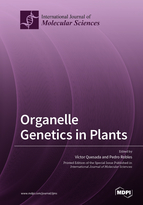Organelle Genetics in Plants
A special issue of International Journal of Molecular Sciences (ISSN 1422-0067). This special issue belongs to the section "Molecular Plant Sciences".
Deadline for manuscript submissions: closed (30 June 2020) | Viewed by 51952
Special Issue Editors
Interests: genetics; plant development; abiotic stress; arabidopsis; chloroplast biogenesis; mTERF; organelle gene expression
Special Issues, Collections and Topics in MDPI journals
Interests: plant genetics; leaf and fruit development; Arabidopsis; organelles and development, mTERF, chlororibosome; organelles stress sensors
Special Issues, Collections and Topics in MDPI journals
Special Issue Information
Dear Colleagues,
Most of the DNA of eukaryotes is located in the nucleus. However, the chloroplasts in photosynthetic organisms and mitochondria in a vast majority of eukaryotes, also contain part of the genetic material of a eukaryotic cell. The organisation and inheritance patterns of this organellar DNA are quite different to that of nuclear DNA.
The presence of DNA in chloroplasts and mitochondria reveals their evolutionary origin. Considerable phylogenetic evidence supports the hypothesis that both organelles come from ancestral free-living prokaryotes that established an endosymbiotic relationship with a primitive eukaryotic cell. Most genes of the ancestral prokaryotes were transferred to the nucleus of the host cell throughout evolution. Consequently, present-day chloroplast and mitochondrial genomes contain only a few dozen genes, required for ATP synthesis, photosynthesis, and gene expression. Nevertheless, chloroplasts and mitochondria harbour several thousand proteins, of which the vast majority are encoded by the nucleus and are, hence, synthesised in the cytoplasm and subsequently transported to their target organelle. As a result, the expression of nuclear and organelle genomes has to be very precisely coordinated.
This Special Issue encourages the publication of both experimental and review papers principally from a molecular genetics and/or mutational perspective, covering a wide range of topics in chloroplast and plant mitochondria research: replication and dynamics of nucleoids, transcriptional and posttranscriptional regulation of gene expression in organelles, organelle translation, protein import into organelles, retrograde and anterograde signalling pathways, organelle biogenesis and plant development, organelle genome sequencing and databases, organelle evolution and technical advances in organelle biotechnology. Other related topics are also welcome.
Assoc. Prof. Dr. Víctor Quesada Pérez
Assoc. Prof. Dr. Pedro Robles
Guest Editors
Manuscript Submission Information
Manuscripts should be submitted online at www.mdpi.com by registering and logging in to this website. Once you are registered, click here to go to the submission form. Manuscripts can be submitted until the deadline. All submissions that pass pre-check are peer-reviewed. Accepted papers will be published continuously in the journal (as soon as accepted) and will be listed together on the special issue website. Research articles, review articles as well as short communications are invited. For planned papers, a title and short abstract (about 100 words) can be sent to the Editorial Office for announcement on this website.
Submitted manuscripts should not have been published previously, nor be under consideration for publication elsewhere (except conference proceedings papers). All manuscripts are thoroughly refereed through a single-blind peer-review process. A guide for authors and other relevant information for submission of manuscripts is available on the Instructions for Authors page. International Journal of Molecular Sciences is an international peer-reviewed open access semimonthly journal published by MDPI.
Please visit the Instructions for Authors page before submitting a manuscript. There is an Article Processing Charge (APC) for publication in this open access journal. For details about the APC please see here. Submitted papers should be well formatted and use good English. Authors may use MDPI's English editing service prior to publication or during author revisions.
Keywords
- Chloroplast and mitochondria biogenesis
- Evolution of organelles
- Organelle nucleoids
- Posttranscriptional regulation in organelles
- Protein import into mitochondria and chloroplasts
- Sequencing of organelle genomes
- Retrograde and anterograde signalling pathways
- Technical advances in organelle biotechnology
- Transcriptional regulation in organelles
- Translation in organelles








